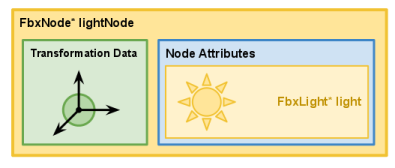FBX Node Attributes
Creating a Node Attribute
A FbxNodeAttribute is paired with a FbxNode to define a scene element with a specific position, rotation and scale. Calling FbxNode::GetNodeAttribute() will return NULL if no node attribute was set for that node.

The following code sample (adapted from ExportScene04/main.cxx to fit the diagram above) illustrates how to create a simple spotlight within a scene. Here, FbxLight* light is the node attribute of FbxNode* lightNode. For more information on lights, see Lights.
// Create a spotlight.
FbxNode* CreateLight(FbxScene* pScene, char* pName)
{
FbxLight* light = FbxLight::Create(pScene,pName);
light->LightType.Set(FbxLight::eSpot);
light->CastLight.Set(true);
FbxNode* lightNode = FbxNode::Create(pScene,pName);
lightNode->SetNodeAttribute(light);
return lightNode;
}Node Attributes
The following table presents a set of basic scene elements and their related FbxNodeAttribute subclasses. These node attributes can be paired with a FbxNode using FbxNode::SetNodeAttribute(). Consult the C++ Reference guide for the full class hierarchy.
| Scene Element | FbxNodeAttribute subclass |
|---|---|
| Camera | FbxCamera, FbxCameraStereo |
| Camera Switcher (custom camera definition in Autodesk MotionBuilder) | FbxCameraSwitcher |
| Light | FbxLight |
| Mesh | FbxMesh |
| Nurb | FbxNurbs, FbxNurbsCurve, FbxNurbsSurface, FbxTrimNurbsSurface |
| Patch / Parametric Surface | FbxPatch |
| Level of Detail Group | FbxLodGroup |
| Marker | FbxMarker |
| Skeleton | FbxSkeleton |
Node Attribute Type
The type (FbxNodeAttribute::EAttributeType) of a FbxNodeAttribute can be obtained by calling FbxNodeAttribute::GetAttributeType(). The EAttributeType is useful for downcasting the node attribute object to its appropriate subclass.
The following code sample (adapted from ImportScene/main.cxx and ImportScene/DisplayLight.cxx) illustrates how to use a switch to display a FbxLight contained in a FbxNode.
//
// Adapted from ImportScene/DisplayLight.cxx ...
// Display the various properties of the FbxLight contained within the FbxNode.
//
void DisplayLight(FbxNode* pNode)
{
FbxLight* lLight = (FbxLight*) pNode->GetNodeAttribute();
DisplayString("Light Name: ", (char *) pNode->GetName());
// ...
char* lLightTypes[] = { "Point", "Directional", "Spot" };
DisplayString(" Type: ", lLightTypes[lLight->LightType.Get()]);
DisplayBool(" Cast Light: ", lLight->CastLight.Get());
if (!(lLight->FileName.Get().IsEmpty()))
{
DisplayString(" Gobo");
DisplayString(" File Name: \"", lLight->FileName.Get().Buffer(), "\"");
DisplayBool(" Ground Projection: ", lLight->DrawGroundProjection.Get());
DisplayBool(" Volumetric Projection: ", lLight->DrawVolumetricLight.Get());
DisplayBool(" Front Volumetric Projection: ", lLight->DrawFrontFacingVolumetricLight.Get());
}
// ...
}
//
// Adapted from ImportScene/main.cxx ...
// Display the contents of a node. Here, we are only interested in
// looking at the eLight attribute type, which coincides with the
// FbxLight node attribute.
//
void DisplayContent(FbxNode* pNode)
{
FbxNodeAttribute::EAttributeType lAttributeType;
int i;
if(pNode->GetNodeAttribute() == NULL)
{
printf("NULL Node Attribute\n\n");
}
else
{
lAttributeType = (pNode->GetNodeAttribute()->GetAttributeType());
switch (lAttributeType)
{
// ...
case FbxNodeAttribute::eLight:
DisplayLight(pNode);
break;
// ...
}
}
// ...
for(i = 0; i < pNode->GetChildCount(); i++)
{
DisplayContent(pNode->GetChild(i));
}
}